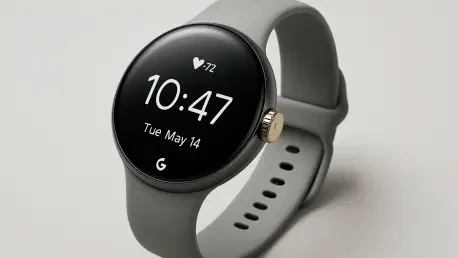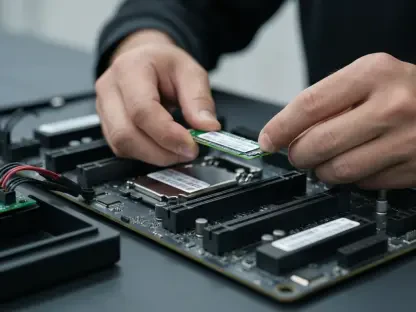Welcome to an exciting deep dive into the world of wearable tech! Today, we’re thrilled to chat with Oscar Vail, a renowned technology expert with a passion for cutting-edge innovations. With his extensive background in emerging fields like quantum computing and robotics, Oscar brings a unique perspective to the latest advancements in consumer tech. In this interview, we’ll explore the standout features of the recently unveiled Google Pixel Watch 4, touching on its innovative design, enhanced performance, sustainability efforts, and the integration of AI-driven capabilities. Let’s get started!
Can you walk us through the new domed display on the Pixel Watch 4 and how it changes the way users interact with the device compared to traditional flat screens?
I’m really impressed with the domed Actua display on the Pixel Watch 4. Unlike the flat screens we’re used to, this physically curved design creates a unique tactile experience. When you swipe across the screen, you can feel the rise and fall of the surface, which adds a sense of depth to the interaction. It also enhances the visuals at the edges, making animations and graphics feel more immersive, thanks to the new interface design. It might take a bit of getting used to, but it offers a larger field of view and makes touchpoints easier to hit.
What do you think prompted the shift to a physically curved design for the display, and how does it stand out in the smartwatch market?
I believe the move to a domed design is about blending aesthetics with functionality. It’s a bold choice that sets the Pixel Watch 4 apart from competitors, giving it a distinctive ‘polished pebble’ look that’s already iconic for the series. Beyond looks, the curve likely helps with durability—domed shapes can often withstand impacts better than flat ones. It’s a statement of innovation in a market where most smartwatches stick to predictable designs, and it shows a willingness to experiment with how we perceive and use wearable screens.
With the display now reaching up to 3,000 nits of brightness, how does this impact usability in various environments?
The jump to 3,000 nits is a game-changer for outdoor use. Whether you’re under harsh sunlight or in a dimly lit room, the screen remains vibrant and readable. For users who are active outdoors—runners, hikers, or just anyone checking notifications on the go—this means no more squinting or cupping your hand over the watch to see the display. It’s a significant upgrade from previous models and ensures the watch is practical in all lighting conditions, which is critical for a device meant to be used on the move.
The Pixel Watch 4 features a redesigned back with screws for easier repairs. What’s the significance of this focus on repairability in today’s smartwatch landscape?
This is a refreshing step forward. Most smartwatches are sealed units, making repairs difficult or impossible without specialized tools or professional help. By adding screws and designing the Pixel Watch 4 to be more serviceable, Google is prioritizing sustainability and consumer value. It’s a rare move in an industry often criticized for planned obsolescence. This design allows for battery replacements and other fixes, which can extend the device’s lifespan and reduce electronic waste—a win for both users and the environment.
How does the new side-charging dock enhance the user experience, especially for those using the watch as a bedside companion?
The shift to a side-charging dock is a clever redesign. Unlike the traditional puck chargers, this setup lets the watch sit on its side, which is perfect for nightstand use. If you’re using the Pixel Watch 4 as an alarm clock, the display faces you directly, making it easy to check the time or tap the crown to snooze without fumbling. It’s a small but thoughtful change that improves convenience, especially for those who rely on their smartwatch to start their day.
With faster charging capabilities—0% to 50% in just 15 minutes—how does this fit into the lifestyle of someone always on the go?
That kind of charging speed is a lifesaver for busy folks. If you’re rushing out the door and realize your watch is low on battery, a quick 15-minute charge gets you halfway there—enough to last through a good chunk of the day. It minimizes downtime and fits seamlessly into hectic schedules, whether you’re squeezing in a charge during a coffee break or while getting ready. It’s one of those features that you don’t realize you need until it saves you in a pinch.
The Pixel Watch 4 boasts a battery life of up to 40 hours on the larger model. What advancements do you think contributed to this improvement?
Achieving up to 40 hours on the 45mm model is impressive, and I think it’s a combination of hardware and software optimizations. The Qualcomm Snapdragon W5 Gen 2 processor, paired with a machine learning coprocessor, likely plays a big role by managing power more efficiently. Additionally, improvements in Wear OS 6.0 and better battery technology probably help squeeze out extra hours. It’s a meaningful boost for users who want a watch that can keep up for more than a day without needing a charge.
Can you share your thoughts on the AI-driven features, like Smart Replies and the upcoming personal health coach, and how they might shape the future of smartwatches?
The AI features on the Pixel Watch 4 are where things get exciting. Smart Replies, powered by an on-device language model, are a huge step up from the generic responses we’ve seen before. They adapt to the context of your messages, which makes communication feel more natural and personal. As for the upcoming AI health coach via Fitbit, I’m intrigued by the potential for personalized guidance based on your health data. If it delivers as promised, it could turn the watch into a true wellness partner, pushing smartwatches beyond mere tracking devices into proactive health management.
What’s your forecast for the role of AI in wearable technology over the next few years?
I see AI becoming the backbone of wearable tech in the near future. We’re already witnessing features like contextual replies and voice-activated assistants on devices like the Pixel Watch 4, but I expect this to evolve into even more intuitive, predictive capabilities. Imagine a smartwatch that anticipates your needs—adjusting workout plans based on your stress levels or reminding you to hydrate before you even feel thirsty. As processing power and algorithms improve, wearables will become less about reacting to inputs and more about understanding and supporting our daily lives in a deeply personalized way.









